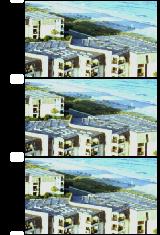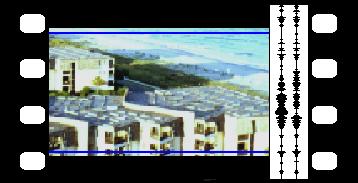

16mm film can be blown up to 35mm, but the image is not as sharp as a movie that was shot on 35mm.
16mm is, of course, a smaller sized format than 35mm. Because their is a smaller surface area to each frame the picture is not as sharp as the larger formats. 16mm frames have an image area that is 1x1.33, just like 35mm film. Because the film is narrower than 35mm there only have to be sprocket holes on one side of the frame. The other side of the frame contains the movie's sound. The sound can either be a mono optical track (like 35mm) or a magnetic track (which is like a cassette tape). In fact, using negatives with a magnetic tape can allow a camera operator to record sound in camera, although these magnetic strips are not known for the best quality. Some 16mm film is available with sprocket holes on both sides (also meaning that there is no sound line.) Although nearly all 16mm cameras use only one set of sprocket holes. This film can be used for special effects like the cheapest reverse motion. If the camera is turned upside down while shooting, and than the film is spliced backwards the image will be turned right-side up and play in reverse. Of course you can not shoot sync sound to a reversed shot, but that is not a problem because 16mm film with 2 sets of sprocket holes is used only for camera negatives, not release prints.


16mm is the format of choice for the extremely low budget film-makers. The equipment is compact, light, and easy to carry around. Once the movie is made it can be either shown in 16mm or transferred to 35mm for release. Very few theaters are equipped for 16mm screenings, so if a film is to ever get a big release it must be transferred to 35mm. Several of the classic exploitation films of the 70s (The Texas Chain Saw Massacre, Last House on the Left, The Evil Dead) were shot on 16mm.
Super 16 was conceived as a way to shoot on 16mm and have a sharper image to transfer to 35mm. Because the sound area on the film is not generally used by professionals when they are shooting a movie it could be eliminated with no problems. This makes the frame 1x1.66. Since the image uses more of the film surface area it does not need to be blown up as much as a regular 16mm image to transfer to 35mm. Since the frames are 1x1.66 they do not completely fill out a 35mm frame. But since most spherical films are matted to be 1x1.85 the blank area of the film would never be seen in theaters. Leaving Las Vegas, Ulee's Gold, & Chasing Amy were shot in Super 16 and transfered to 35mm for their releases.


Some TV shows are also shot on Super 16. Most TV shows are shot on film because films has a certain look to it that regular video does not. For a comparison watch almost any hour long prime time drama and than watch a soap opera. Soaps are shot on video because it is faster but the quality noticeably suffers. Most shows that are shot on film have the raw footage transferred to video for post-production. Since most TV shows will never be shown on large theatrical screens, Super 16 has a resolution that is indistinguishable from 35mm when shown on TV. Also because Super 16 is wider than current TVs many shows are shot so that when Digital 16x9 TVs become standard they can remaster the shows for 16x9. Babylon 5 was the first show to be shot in 16x9. Homicide Life on the Streets, Martial Law & The Outer Limits are all shot on Super 16 film.

8mm is about the smallest motion picture format. It has never been a "professional" format for anyone except for old time news reporters. Most of the people who have used it have shooting home movies or been aspiring film-makers. These days you always see at least one dad with a video camera at every child's school event. Back in the 1950s you always saw at least one dad with an 8mm camera at every school event. Sam Raimi and his buddy Bruce Campbell (who went on to make The Evil Dead) used to soot their own amateur short films on super-8 (see below) as children. Raimi said that he thinks that it was better training than kids today who use video cameras because 8mm uses all the same principles as the larger film formats (i.e. interchangeable lens, F-stop, frame rate, exposure levels) A standard 8mm image has less resolution than a standard TV image. Some music video directors use 8mm because they like the style that comes with the graininess of the picture (Rob Zombie's Living Dead Girl music video looks like 8mm although I do not know if he shot on 8mm or just used some tricks in post-production to make it look like 8mm.)
When 8mm was first invented the sprocket holes were the same size as those on 16mm film, so they took up a large portion of the frame.


Later on they increased the image area of the frame by making the sprocket holes smaller. This was called Super-8 and it is when 8mm really became big. Super-8 was the format that Sam Raimi and his future Evil Dead buddies used to discover film-making as children. Their was also a super-8 format that was introduced that had sound built into the film. On the opposite side of the film from the sprocket holes there was a magnetic strip that sound could be recorded on like a cassette tape.


One interesting permutation of 8mm that came about is "double 8mm". For this format the film was 16 millimeters wide, but only half of the film would be exposed at one time. After exposing one side of the film the camera operator would have to flip the film magazine around and run the film though again, this would expose the other side of the film. When the film was developed the photo lab would print out the 2 sides separately onto a single strip of 8mm film. This strip of 8mm film would be twice as long as the original strip of "double 8mm" had been, but only half the width. The attraction of this format is that since each cartridge could be flipped and used a second time you could shoot twice as much footage without carrying twice as many cartridges of film.


Copyright 2000 by:
Brian Fitzgerald